ADHRRF Reports
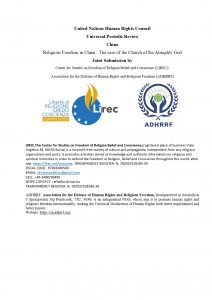
United Nations Human Rights Council Universal Periodic Review China Religious Freedom in China : The case of The Church of Almighty God Joint Submission by Center for Studies on Freedom of Religion Belief and Conscience (LIREC); Association for the Defense of Human Rights and Religious Freedom (ADHRRF) LIREC,The Center for Studies on Freedom of Religion Belief and Conscience,(registered place of business Viale Angelico 38, 00195 Roma) is a no-profit free society of culture and propaganda, independent from any religious organization and party. It promotes activities aimed at knowledge and authentic ...
Safeguard Defenders' Reports
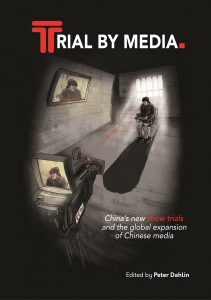
Trial By Media: China’s new show trials, and the global expansion of Chinese media (2018). Edited by Peter Dahlin. Through the use of first-person accounts from victims, this book explains in detail how China’s forced TV confessions are made and exposes the active role China’s state media has played in creating them via its collaboration with police. It also charts the Party’s tightening control over the media and its aggressive international expansion. Source: Fundacion Safeguard Defenders ...
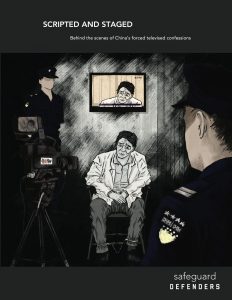
Scripted and Staged: Behind the scenes of China’s forced TV confessions (2018). This groundbreaking and illustrated report was the first of its kind to expose the reality behind China’s Forced TV Confessions that have been beamed around the world on China’s state TV channel CGTN. Through the use of victim stories, the reader gains a better understanding of how these show confessions are coerced and staged. Also availble as a full-color book in A4 format on Amazon worldwide. Source: Fundacion Safeguard Defenders ...
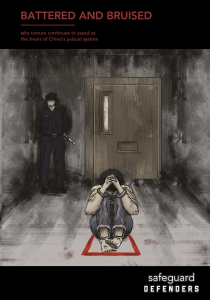
Battered and Bruised: Why torture continues to stand at the heart of China’s judicial system (2018). This report is based on research conducted by a group of Chinese lawyers with experience trying to protect their clients from torture and to secure the disqualification of confessions procured through torture. Battered and Bruised documents commonly practiced torture methods and why the country’s legal system continues to fail to prevent its use. Source: Fundacion Safeguard Defenders ...
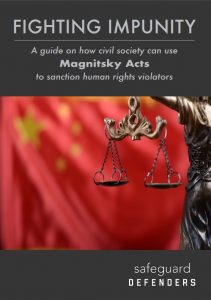
Fighting Impunity: A guide on how civil society can use Magnitsky Acts to sanction human rights violators (2020). The first-ever comprehensive guide, based on candid and anonymous interviews with diplomats, government officials, and study of past work with submitting human rights violators for sanctions. Offers step by step guidance on how to file violators for sanctioning using best practice methods. (1-page spread edition) Source: Fundacion Safeguard Defenders ...
U.S. Department of State’s Reports
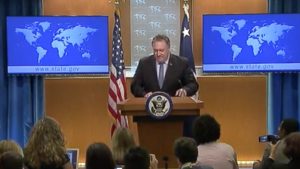
Executive Summary IN THIS SECTION: CHINA | TIBET (BELOW) | XINJIANG The United States recognizes the Tibetan Autonomous Region (TAR) and Tibetan autonomous prefectures and counties in other provinces to be part of the People’s Republic of China. The constitution of the People’s Republic of China states citizens “enjoy freedom of religious belief” but limits protections for religious practice to “normal religious activities” without defining “normal.” Central government regulations implemented February 1 stipulate religious activity “must not harm national security” and place new restrictions on religious schools, donations, and travel. In the TAR and other ...

Executive Summary IN THIS SECTION: CHINA | TIBET | XINJIANG (BELOW) This separate section on Xinjiang is included given the scope and severity of reported religious freedom violations specific to the region this year. Multiple media and NGOs estimated the government detained at least 800,000 and up to possibly more than 2 million Uighurs, ethnic Kazakhs, and members of other Muslim groups, mostly Chinese citizens, in specially built or converted detention facilities in Xinjiang and subjected them to forced disappearance, torture, physical abuse, and prolonged detention without trial because of their religion and ethnicity ...

Executive Summary IN THIS SECTION: CHINA (BELOW) | TIBET | XINJIANG Reports on Hong Kong, Macau, and Tibet are appended at the end of this report. Given the scope and severity of reported religious freedom violations specific to Xinjiang this year, a separate section on the region is also included in this report. The constitution states citizens have freedom of religious belief but limits protections for religious practice to “normal religious activities” and does not define “normal.” The government continued to exercise control over religion and restrict the activities and personal freedom of ...
The Church of Almighty God’s Reports
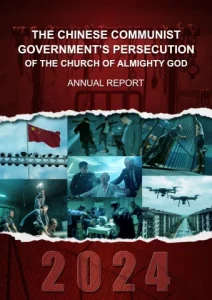
1. Overview In 2024, the Chinese Communist Party (CCP) continued advancing its campaign for the “Sinicization” of religion. On January 1, it enacted the Patriotic Education Law of the People’s Republic of China1, further tightening its control and suppression of religious practices. Many churches were forced to display pro-CCP slogans, replace Sunday worship with performances of “Red Songs2”, and substitute sermons on the Bible with lectures on the history of the CCP’s rise to power. House churches that refused to join the state-controlled Three-Self Church were persistently labeled as “cults” ...
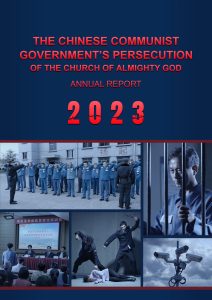
Today, February 7, 2024, The Church of Almighty God (CAG) released its 2023 Annual Report on the Chinese Communist Government’s (CCP) Persecution of The Church of Almighty God. At least 12,463 CAG Christians were arrested in 2023, with 2,207 sentenced to prison and 20 persecuted to death. The number of CAG members arrested and sentenced in China has reached a record high since the CAG published its first annual report in 2017. According to the report, in the name of pandemic prevention, the CCP has made great efforts to develop ...
英语-20210131-GY-RGB-212x300.jpg)
1. Overview 1.1 The CCP Continued Its Religious Persecution Through the 2020 COVID-19 Epidemic The Chinese Communist Party’s coverup of the novel coronavirus put the entire world in peril in 2020. In the face of this disaster, as the people struggled just to get by, the CCP insisted on putting the maintenance of its totalitarian rule first and intensified its efforts to maintain stability, viewing religious beliefs as a “major threat” to its absolute rule. Its persecution intensified rather than eased, and even during periods of quarantine due to the ...
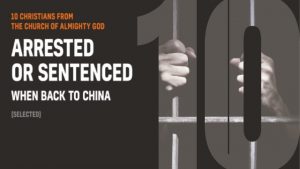
The Church of Almighty God (CAG) is a Christian church founded in China in 1991. It teaches that Almighty God is the second coming of the Lord Jesus. He has uttered millions of words to uncover all the mysteries held within the Bible and delivered all truths necessary for the purification and salvation of mankind, thus enabling people to have a true understanding of the work and disposition of God, to have their corruption cleansed, and to attain His salvation. Ever since Almighty God appeared to perform His work, the ...
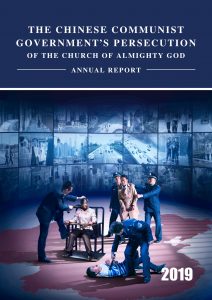
1. Overview 1.1 In 2019, Religious Persecution in China Generally Worsened Under Xi Jinping’s Rule In 2019, authorities of the Chinese Communist Party (CCP) headed by Xi Jinping continued to make strong efforts to implement the new Regulations on Religious Affairs throughout the country and to accelerate the “Sinicization” of religion. Claiming that “Religion is vying against the Party in every field for ideological territory and people’s hearts,” authorities have comprehensively suppressed religious belief in order to realize their preposterous aim to “accelerate and promote the demise of religion” and ...
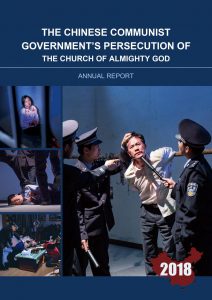
1. Overview 1.1 The Current State of Religion in China, Under the “Sinicization” of Religion Policy On February 1, 2018, the CCP began to implement its new Regulations on Religious Affairs, thereby throwing a cloak of legitimacy over Xi Jinping’s “Sinicization” of religion policy and further exposing the evil purpose behind the CCP’s attempts to completely ban religious beliefs and eradicate all religions in China. After these regulations were implemented, the situation of religious belief in China has wholly deteriorated: More than a million Muslims in Xinjiang have been imprisoned in ...
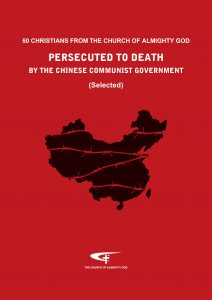
1. Christian Xie Yongjiang Tortured to Death by Chinese Communist Police 2. Christian Zhan Hongmei Brutally Beaten to Death by Chinese Communist Police 3. Christian Gao Cuiqin Electrocuted to Death by Chinese Communist Police 4. Church Leader He Chengrong Tortured to Death by Chinese Communist Police 5. Christian Li Suansuan Injured and Killed by Chinese Communist Government 6. Christian Zhang Zhaoqi Beaten to Death With Stick by Chinese Communist Police 7. Church Leader Jiang Guizhi Ravaged to Death by Chinese Communist Government 8. Preacher Ye Aizhong Electrocuted to Death by Chinese Communist Police ...
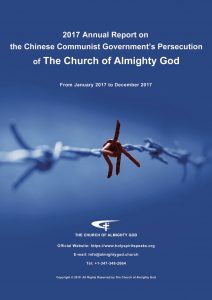
2017 Annual Report on the ChineseCommunist Government’s Persecutionof The Church of Almighty God In October 2017, after collecting data on the Chinese Communist Government’s persecution of The Church of Almighty God Christians from January to September 2017, we compiled and released the 2017 Annual Report on the Chinese Communist Government’s Persecution of The Church of Almighty God. Because of the mass arrests and close supervision by the government, many Christians, as a result of their persecution, were unable to provide their own input before the report was published. Following its ...
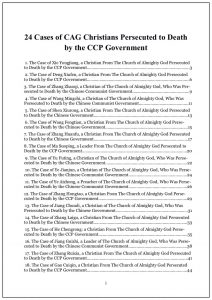
24 Cases of CAG Christians Persecuted to Death 1. The Case of Xie Yongjiang, a Christian From The Church of Almighty God Persecuted to Death by the CCP Government 2. The Case of Deng Xiufen, a Christian From The Church of Almighty God Persecuted to Death by the CCP Government 3. The Case of Zhang Zhaoqi, a Christian of The Church of Almighty God, Who Was Persecuted to Death by the Chinese Communist Government 4. The Case of Wang Mingchi, a Christian of The Church of Almighty God, Who Was ...
2017 Annual Briefing on the Chinese Communist Government’s Persecution of The Church of Almighty God
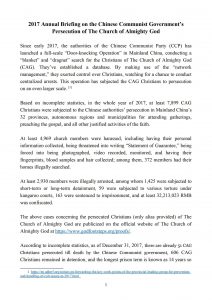
Since early 2017, the authorities of the Chinese Communist Party (CCP) has launched a full-scale “Door-knocking Operation” in Mainland China, conducting a “blanket” and “dragnet” search for the Christians of The Church of Almighty God (CAG). They’ve established a database. By making use of the “network management,” they exerted control over Christians, watching for a chance to conduct centralized arrests. This operation has subjected the CAG Christians to persecution on an even larger scale. Based on incomplete statistics, in the whole year of 2017, at least 7,899 CAG Christians were ...
Amnesty International’s Reports
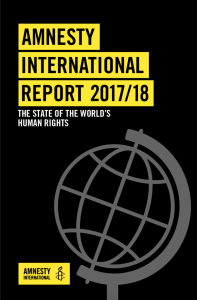
The Amnesty International Report 2017/18 documents the state of the world’s human rights in 159 countries and territories during 2017. Conflict, austerity measures and natural disasters pushed many into deeper poverty and insecurity; millions were forced to flee their homes and seek refuge elsewhere in their own countries or across international borders. Discrimination remained rife in all regions of the world, and at times had deadly consequences for the victims. Governments of all persuasions continued to crack down on the rights to freedom of expression, association and assembly. https://www.amnesty.org/en/documents/pol10/6700/2018/en/ Amnesty ...
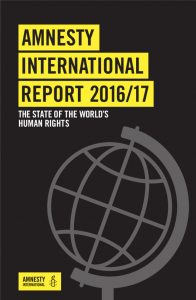
The Amnesty International Report 2016/17 documents the state of human rights in 159 countries and territories during 2016. For millions, 2016 was a year of unrelenting misery and fear, as governments and armed groups abused human rights in a multitude of ways. Large numbers of people continued to flee conflict and repression in many regions of the world. Among other pervasive issues, this report documents continuing torture and other ill-treatment, the failure to uphold sexual and reproductive rights, government surveillance, and a culture of impunity for past crimes. https://www.amnesty.org/en/documents/pol10/4800/2017/en/ Amnesty ...

The Amnesty International Report 2015/16 documents the state of human rights in 160 countries and territories during 2015. In many regions, large numbers of refugees were on the move against a backdrop of conflict and repression. Torture and the failure to uphold sexual and reproductive rights were key concerns. Government surveillance and impunity continued to deny many their rights. This report also celebrates those who stand up for human rights across the world, often in difficult and dangerous circumstances. It is essential reading for policy makers, activists and anyone with ...
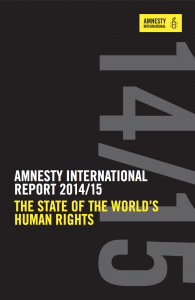
The Amnesty International Report 2014/15 documents the state of human rights in 160 countries and territories during 2014. Some key events from 2013 are also reported. While 2014 saw violent conflict and the failure of many governments to safeguard the rights and safety of civilians, significant progress was also witnessed in the safeguarding and securing of certain human rights. Key anniversaries, including the commemoration of the Bhopal gas leak in 1984 and the Rwanda genocide in 1994, as well as reflections on 30 years since the adoption of the UN ...
Human Rights Watch’s Reports

By 2030, Xinjiang will build six more specialized hospitals. Why, given that the region has a very low organ donation rate? A hospital in Urumqi.jun jin luo–CC BY 3.0 On July 3, the International Coalition to End Transplant Abuse in China (ETAC) raised alarms about a worrying trend: the potential increase in forced organ harvesting from Uyghurs. This concern follows a recent announcement by health officials in the Xinjiang Uyghur Autonomous Region about plans to greatly expand their organ transplant facilities. The official announcement details a new plan to build ...
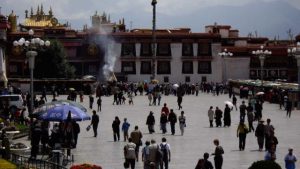
(Chanilim714 – CC BY-SA 3.0) Chinese authorities in the Tibetan Autonomous Region recently announced a campaign aimed at stamping out rumors and misinformation, but Tibet analysts say that its true purpose is to stifle freedom of expression, especially among advocates of Tibetan independence. According to an April 1 report in the China Tibet Online, the 17-point “Squash Rumors and Reactionary Activities” campaign offers prizes for people who tip off authorities to a wide swath of illegal activities. Tipsters can earn between 1,000 and 10,000 yuan (U.S. $141-$1,410) for reporting on ...
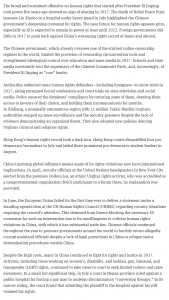
Photo Source: Human Rights Watch.China Events of 2017 © 2018 by Human Rights Watch. The broad and sustained offensive on human rights that started after President Xi Jinping took power five years ago showed no sign of abating in 2017. The death of Nobel Peace Prize laureate Liu Xiaobo in a hospital under heavy guard in July highlighted the Chinese government’s deepening contempt for rights. The near future for human rights appears grim, especially as Xi is expected to remain in power at least until 2022. Foreign governments did little ...
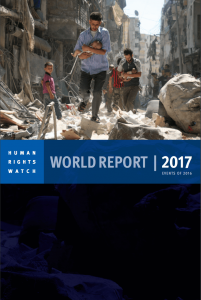
World Report 2017 summarizes key human rights issues in more than 90 countries and territories worldwide. It reflects investigative work that Human Rights Watch staff undertook in 2016, usually in close partnership with human rights activists in the country in focus. In his introductory essay, Executive Director Kenneth Roth writes that a new generation of authoritarian populists seeks to overturn the concept of human rights protections, treating rights not as an essential check on official power but as an impediment to the majority will. https://www.hrw.org/sites/default/files/world_report_download/wr2017-web.pdf Human Rights Watch. Human Rights ...
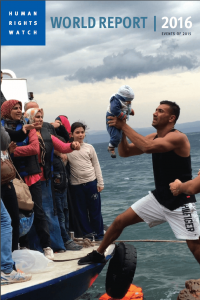
World Report 2016 summarizes key human rights issues in more than 90 countries and territories worldwide. It reflects investigative work that Human Rights Watch staff undertook in 2015, usually in close partnership with human rights activists in the country in focus. In his keynote essay, Human Rights Watch Executive Director Kenneth Roth details how fear drove global developments of 2015. Fears of terror attacks and potential impact of refugee influx led to a scaling back of rights in Europe and other regions. In China, Ethiopia, India, and Russia, fears that ...
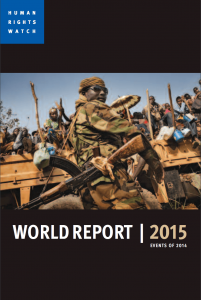
World Report 2015 is Human Rights Watch’s 25th annual review of human rights practices around the globe. It summarizes key human rights issues in more than 90 countries and territories worldwide. In his keynote, Human Rights Watch Executive Director Kenneth Roth reflects on a year so tumultuous, “it can seem as if the world is unraveling.” Surveying several of the year’s most daunting security challenges—including the rise of the extremist group Islamic State (also known as ISIS), China’s crackdown on Uighurs in Xinjiang, and Mexico’s abuse-riddled war on drugs—Roth stresses ...
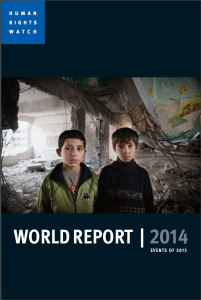
World Report 2014 is Human Rights Watch’s 24th annual review of human rights practices around the globe. It summarizes key human rights issues in more than 90 countries and territories worldwide, drawing on events through November 2013. Reflecting on the “Rights Struggles of 2013,” Executive Director Kenneth Roth highlights the slaughter of civilians in Syria in the face of a weak international response; “abusive majoritarianism” among governments who voice commitment to democracy but in reality use the real or perceived preferences of the majority to limit dissent and suppress minorities; ...
ChinaAid’s Reports

Introduction: Churches and Christians in mainland China under the reign of “coronated” Xi Jinping In 2017, the Chinese Communist Party’s (CCP) Constitution, passed at the CCP’s 19th National Congress, clearly “coronated” President Xi Jinping as yet another emperor of China’s Red Dynasty since Mao Zedong. Although it is too early to tell how this event will impact the development of Christianity in China and the future path of China as a nation, its critical influence is beyond dispute. Factors that influenced Christian churches and Christians in mainland China most directly ...
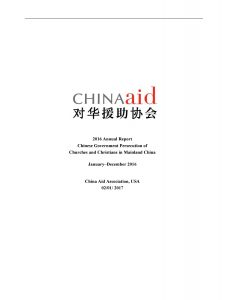
2016 Annual Report Chinese Government Persecution of Churches and Christians in Mainland China Introduction: Sinicization officially unveiled, Party’s shadow envelops churches and Christians in mainland China 2016 heralded key changes to religious freedom in mainland China as the Chinese Communist Party’s [CCP] core principle in managing religious affairs changed from “active guidance of religion and socialism to mutually adapt” to “persistently following the path of religious Sinicization.” Ushered in by the National Conference on Religious Work in April 2016, these alterations mark a critical shift in how the Party views ...


